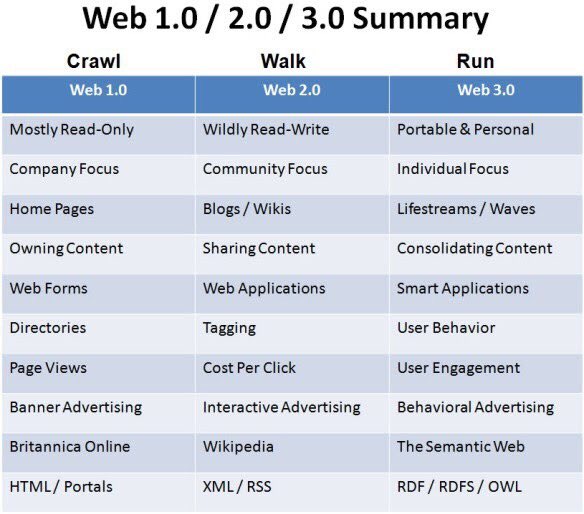Whats is web3.0
May 09, 2022
What is Web3.0
About 1 year ago I bloged about web evolution from web1.0 to web3. Have been getting many request from people to give them an overview of exactly is web3.0 and why it's trending.
I have been learning on my own how to build Decentralized applications trying to get web3.0 out of theories. The Idea of writing an article on this concept just popped up. And here we go with a basic understanding of what is web3.0
Web evelutions
It's not always easy to understand what is web3.0 without knowing the previous two versions of web, web1.0 and web2.0
Web 1.0
It’s kind of “read-only” web where you can only read the Internet pages. There is minimum user’s interaction who can only search and read information which was put there by the web-site’s managers/creators.
Web 2.0
It’s a “read and write” web where users interact with the Internet, it’s a collaboration of both of them. As an example, You tube, Facebook and My space illustrate the meaning of this kind of web.
The users are involved to contribute their submissions which provide the “life” of this web. It a social networking, where the community is creator and user at the same time. The “democratic” nature of the Web 2.0 allows users to tag, link or comment on the web content.
Web 3.0
It’s a new age Internet tech which provides broader search for information through simpler interfaces. It’s called “Semantic Web” by the inventor of the World Wide Web, Tim Berners-Lee. It provides a higly specialized search of the information user are looking for
For instance, there is an ability to make a complex question which is analyzing by the search engine and all possible alternatives are organising. Web 3.0 creates the collection of databases which can be connected on demand.
Why web 3.0 is tranding
The next frontier of the internet’s evolution, Web 3.0, promises a decentralized, permissionless and open-source alternative that will transform computing, data storage and peer-to-peer transactions.
For one, it will eliminate freeloading third parties, giving back the ownership of private data and enabling users to monetize it as a product.
Second, Web 3.0 will enable fractionalized and mutual digital ownership of property, assets, organizations, and everything in between — leading to a trustless, global macroeconomy, where participants can collaborate toward common incentives.
Third, tomorrow’s ownerless companies and organizations will become more resilient, where each stakeholder is a partial owner.
Web 3.0 aims to create this future with a collection of underlying technologies like blockchain, artificial intelligence (AI) and the Internet of Things (IoT).
The philosophy behind Web 3.0 is that websites will be able to interpret user data and continuously become smarter — offering an improved digital experience.
There are some early implementations that you might have experienced if you recently shopped on Amazon. For instance, when you’re shopping for a laptop, the e-commerce platform will automatically recommend a set of related items based on what shoppers with similar profiles have also bought. Amazon is already using the customer’s digital footprint to evolve and make more relevant recommendations.
Web 3.0 users will reclaim the sole ownership of their data, and they’ll be compensated for it, instead of internet giants exploiting their information and selling it to third-party advertisers. Sharing personal information will be optional for each individual.
Internet users are also hoping that the semantic web will be the end of disruptive advertising, which is the current standard of Web 2.0. The user experience would no longer be interrupted by never-ending pop-ups and unskippable ads. Instead, users will regain control of their precious time, choosing if and how many ads they want to see and be compensated accordingly.
From forkast.news, open the link to read more
The future with web4 and web5
However, inspite on the convenience of the research, there is a possibility to get not accurate result. The 4.0 & 5.0 are still under process and will bring human emotions & implanted neuralink to interact with web

